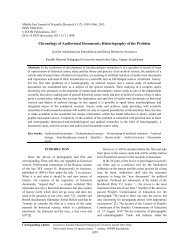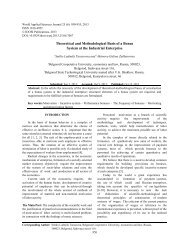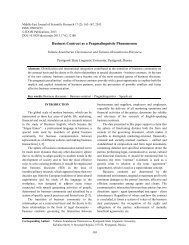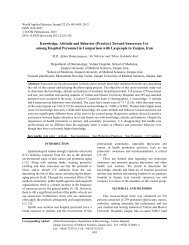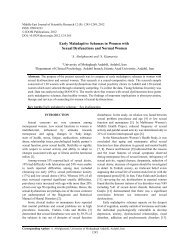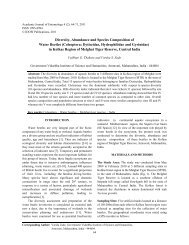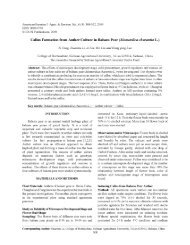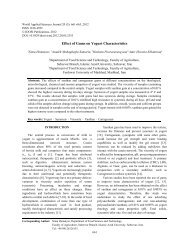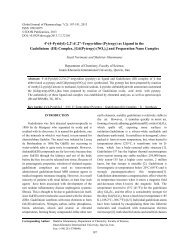Antiglycation, Antioxidant and Anti Lipid Peroxidation ... - Idosi.org
Antiglycation, Antioxidant and Anti Lipid Peroxidation ... - Idosi.org
Antiglycation, Antioxidant and Anti Lipid Peroxidation ... - Idosi.org
Create successful ePaper yourself
Turn your PDF publications into a flip-book with our unique Google optimized e-Paper software.
Middle-East Journal of Scientific Research 11 (6): 814-818, 2012<br />
ISSN 1990-9233<br />
© IDOSI Publications, 2012<br />
<strong><strong>Anti</strong>glycation</strong>, <strong><strong>Anti</strong>oxidant</strong> <strong>and</strong> <strong>Anti</strong> <strong>Lipid</strong> <strong>Peroxidation</strong> Activities of<br />
Microcephala lamelatta With Low Cytotoxic Effects In vitro<br />
1,2 3 1<br />
Ghulam Abbas, Muhammad Shahzad, Muhammad Jawad Hassan,<br />
4 5<br />
Rasool Bakhash Tareen <strong>and</strong> Muhammad Iqbal Choudhary<br />
1<br />
Department of Biochemistry, University of Health Sciences, Lahore, 54600, Pakistan<br />
2<br />
Department of Chemistry, CIIT, Abbottabad, Abbottabad-22060, Pakistan<br />
3<br />
Department of Pharmacology, University of Health Sciences, Lahore, 54600, Pakistan<br />
4<br />
Department of Botany, University of Baluchistan, Quetta, Pakistan<br />
5<br />
International Center for Chemical <strong>and</strong> Biological Sciences, HEJ Research Institute<br />
of Chemistry, University of Karachi, Karachi-75270, Pakistan<br />
Abstract: Non-enzymatic protein glycation, oxidative stress <strong>and</strong> lipid peroxidation are the fundamental<br />
processes which are closely associated with various biological disorders particularly diabetes <strong>and</strong> late diabetic<br />
complications. Plant Microcephala lamellata (Bunge) Pobed, is the member of family Asteraceae which is<br />
widely used as folk medicine. To the best of our knowledge there are no previous reports regarding<br />
antiglycation, anti lipid peroxidation, antioxidant <strong>and</strong> cytotoxicity studies of M. lamellata. In this study we<br />
prepared various fractions of M. lamellata <strong>and</strong> among all five tested fractions, ethyl acetate fraction exhibited<br />
a significant antioxidant activity (IC 50= 106.314±1.021 µg/mL) while crude methanolic extract showed moderate<br />
antioxidant activity (IC 50=213.021±2.216 µg/mL) on 1,1-Diphenyl-2-picrylhydrazyl (DPPH) radical scavenging<br />
assay. Ethyl acetate fraction <strong>and</strong> crude methanolic extract exhibited significant antiglycation activity with<br />
IC 50 values = 165.594±2.732 <strong>and</strong> 235.712 ±3.238 µg/mL, respectively while on thiobarbeturic acid reactive<br />
substance (TBARs) assay dichloro methane <strong>and</strong> crude methanolic extract showed 72.52% <strong>and</strong> 62.84% inhibition<br />
respectively. In cytotoxicity assay against mouse 3T3 fibroblast cells, dichloro methane fraction showed<br />
moderate toxicity with IC 50 values = 12.367±0.56 µg/mL, while rest of the fractions were non-toxic on cytotoxicity<br />
test with IC 50 values greater than 30 µg/mL. In conclusion, the crude methanolic extract <strong>and</strong> ethyl acetate<br />
fraction of M. lamellata are more active against protein glycation, free radicals <strong>and</strong> lipid peroxidation.<br />
Key words: Protein glycation Oxidative stress Microcephala lamellate <strong><strong>Anti</strong>oxidant</strong>s <strong>Lipid</strong><br />
peroxidation Cytotoxicity<br />
INTRODUCTION<br />
enzymatic protein glycation are key processes in the<br />
development of diabetes mellitus <strong>and</strong> related<br />
Free radicals derived from glycated proteins are complications [5, 6]. Despite the availability of the<br />
one of the major causes of protein fragmentation <strong>and</strong> current therapies for prevention of the protein<br />
oxidation of lipids <strong>and</strong> nucleic acids [1, 2]. Advanced glycation <strong>and</strong> oxygen stress related diseases are still a<br />
glycation endproducts (AGEs) induce lipid peroxidation major threat to human health. <strong><strong>Anti</strong>oxidant</strong>s effectively<br />
by a direct reaction between glucose <strong>and</strong> amino groups protect against glycation derived free radicals <strong>and</strong> may<br />
on phospholipids [3]. Membrane lipids are mainly have therapeutic potential for the inhibition of radical<br />
susceptible to oxidation due to their high concentration induced processes [7]. Moreover, plant samples with<br />
of polyunsaturated fatty acids <strong>and</strong> they are associated combined antioxidant, antiglycation <strong>and</strong> anti lipid per<br />
with enzymatic <strong>and</strong> non-enzymatic systems thus oxidation properties are highly desired because they<br />
generate free radical species [4]. It is therefore established can be more effective in treating various biological<br />
that oxidative stress, lipid per oxidation <strong>and</strong> non- disorders [8].<br />
Corresponding Author:<br />
Ghulam Abbas, Department of Biochemistry, University of Health Sciences, Lahore, 54600, Pakistan.<br />
Tel: +92-992-383591-7, +92-333-4079766, Fax: +92-992-383441.<br />
814
Middle-East J. Sci. Res., 11 (6): 814-818, 2012<br />
The plant Microcephala lamellata (Bunge) Pobed, trichloro acetic acid (TCA) from Scharlau. Phosphate<br />
belongs to family Asteraceae which is widely distributed buffer (pH 7.4), phosphate buffer saline (pH 10) <strong>and</strong> rutin<br />
in Ziarat, Baluchistan, Pakistan. It is erect or ascending, were purchased from Carl Roth.<br />
profusely branched above, up to 50 cm tall, glabrous herb<br />
with sulcate or obtusely angled internodes while Reagents for <strong>Lipid</strong> <strong>Peroxidation</strong> (TBARs) Assay:<br />
flowering period is April to August. Traditionally the Phosphotidyl choline (substrate), Thiobarbituric Acid<br />
plant has been used to treat jaundice, long st<strong>and</strong>ing fever, (TBA), Quercetin, Trichloro acetic acid (TCA), Butylated<br />
colic pain <strong>and</strong> the dysentery of children [9], which also hydroxyanisole (BHA) were purchased from Sigma<br />
show its non-toxic effects. To the best of our knowledge Aldrich while Ferrous Sulphate was purchased from Roth,<br />
plant M. lamellata was not previously evaluated for these Tris-HCL buffer pH.7.1 <strong>and</strong> Double Distilled Water<br />
bioactivities.<br />
(DDW) were also used in this assay.<br />
MATERIALS AND METHODS<br />
Reagents for Cytotoxicity Assays: Reagents for<br />
cytotoxicity assay were purchased as mouse fibroblast<br />
Plant Extraction: The plant Microcephala lamellata was (3T3) from European American Culture Collection (EACC),<br />
collected from Ziarat, Baluchistan, Pakistan. The Plant was Dulbecco’s Modified Eagle’s Medium (DMEM) from<br />
identified <strong>and</strong> confirmed by Department of Botany, Sigma-Aldrich, Fetal Bovine Serum (FBS) from GIBCO-<br />
University of Baluchistan, Quetta, Pakistan. The whole BRL,MTT (3-[4,5-dimethylthiazole-2-yl]-2,5- diphenylplant<br />
of M. lamellata was dried in dark, chopped <strong>and</strong> tetrazolium bromide) from Amresco, Penicillin <strong>and</strong><br />
grinded to coarse powder. The powdered plant (500 gm) Streptomycin from Sigma- Aldrich, Trypsin /EDTA(0.25%)<br />
was initially extracted with methanol for 24 hours at room from GIBCO.<br />
temperature with occasional stirring. The process was<br />
repeated three times <strong>and</strong> the combined extracts were DPPH Radical Scavenging Assay: Free radical<br />
concentrated under reduced pressure in rotary evaporator scavenging activities of the test compounds were<br />
to give the crude methanol extract as a gummy residue. A determined by measuring the change in absorbance of<br />
part of crude methanol extract was stored for further DPPH (l,l-Diphenyl-2-picrylhydrazyl radical) at 515 nm<br />
analysis while the remaining extract was dissolved <strong>and</strong> by the spectrophotometric method described by<br />
suspended in distilled water. The suspension was S.K. Lee [10]. In this assay, reaction mixture<br />
partitioned successively in various fractions though comprised of 95 µL (0.3mM) of ethanolic solution of<br />
separating funnel using n-hexane, dichloromethane <strong>and</strong> DPPH’ <strong>and</strong> 5 µL of the plant fraction (0.5mg/mL)<br />
ethyl acetate. The <strong>org</strong>anic fractions were condensed dissolved in DMSO.<br />
down under vacuum while the aqueous fractions were<br />
concentrated in the freeze drier. All the fractions were Superoxide Anion Assay: The reaction was performed in<br />
stored at 4°C.<br />
triplicate in a 96-well plate <strong>and</strong> the absorbance was<br />
measured on multiplate reader (Spectra Max 340). The<br />
Reagents for DPPH <strong>and</strong> Superoxide Assays: 1,l- reaction mixture contained 40 µL(0.2mM)of nicotinamide<br />
Diphenyl-2-picryIhydrazylradical (DPPH), adenine dinucleotide (NADH), 40 µL(0.018mM)<br />
naphthylethylenediamine, potassium dihydrogen nitroblue tetrazolium (NBT), 90 µL of (100mM) phosphate<br />
phosphate, dipotassium hydrogen phosphate, 3- (2- buffer pH 7.4 <strong>and</strong> 10 µL (0.5mg/mL) of the test samples<br />
pyridyl)-5,6-di(p-sulfophenyl)-1,2,4-triazine (disodium salt (Plant extracts) pre-read at 560nm. The reaction was<br />
or ferrozine), reduced -nicotinamide adenine dinucleotide initiated by the addition of 20 µL (0.008mM) of phenazine<br />
(NADH), 5- methylphenazium methyl sulfate (PMS), methosulphate (PMS) <strong>and</strong> then incubated at room<br />
nitro blue tetrazolium salt (NBT) <strong>and</strong> st<strong>and</strong>ard radical temperature for 5 minutes. Formation of blue color<br />
scavengers Propyl gallate (propyl 3,4,5- formazan dye was measured at 560 nm. The control<br />
trihydroxybenzoate) were purchased mainly from Sigma contained 10 µL of DMSO, instead of the test compound.<br />
Chemical Co.<br />
The solutions of NBT, NADH <strong>and</strong> PMS were prepared in<br />
phosphate buffer, while the test fractions were dissolved<br />
Reagents for <strong><strong>Anti</strong>glycation</strong> Assay: Bovine Serum in DMSO [11].<br />
Albumin (BSA) from Research Organics, anhydrous The radical scavenging activities (%) were calculated<br />
D-glucose from Fisher Scientific, Sodium azide <strong>and</strong> by using the following formula:<br />
815
Middle-East J. Sci. Res., 11 (6): 814-818, 2012<br />
% RSA = [100-(AS/AC * 100)]<br />
2<br />
supplemented with 5% (FBS), by using a 75 cm flask in a<br />
5% CO 2 incubator at 37°C. Cycloheximide was used as a<br />
RSA is radical scavenging activity, AS is the st<strong>and</strong>ard (IC 50= 0.3 ± 0.089 µM).<br />
absorbance of radicals <strong>and</strong> formazan dye in the presence<br />
of test sample <strong>and</strong> AC is the absorbance of formazan dye Statistical Analysis: The results were expressed as<br />
without sample (control).<br />
mean ± SEM <strong>and</strong> the EZ-fit software (Perrella Scientific<br />
Inc., Amherst, U.S.A.) was used to calculate the IC 50<br />
<strong><strong>Anti</strong>glycation</strong> Assay Protocol: BSA-fluorescent assay values (µg/mL). IC 50 values were measured by using<br />
was used as described previously by Choudhary [12]. different concentrations of the active samples.<br />
In this assay 0.5 mg/mL of unknown inhibitors (fractions)<br />
were dissolved in DMSO, along with st<strong>and</strong>ard inhibitor.<br />
RESULT AND DISCUSSION<br />
The comparison of fluorescence intensity at 370 nm<br />
excitations <strong>and</strong> emission at 440 nm was obtained by using Screening of traditionally used plants <strong>and</strong> discovery<br />
spectrofluorimeter [13-15]. Rutin, a st<strong>and</strong>ard inhibitor, of their active components with combined antioxidant <strong>and</strong><br />
showed IC 50 value 98.01±2.03 µM.<br />
antiglycation properties would be beneficial in the<br />
treatment of various disorders [17].<br />
<strong>Anti</strong> <strong>Lipid</strong> per Oxidation Assay: <strong>Lipid</strong> peroxidation, an Ziarat a city of Baluchistan, Pakistan has enormous<br />
indicator of tissue injury induced by reactive oxygen floral resources which are being used traditionally for the<br />
species is measured as thiobarbituric acid reactive treatment of various ailments. The close relationship<br />
substance (TBARS). The amount of tissue TBARS was between free radicals generation, lipid peroxidation <strong>and</strong><br />
measured by the thiobarbituric acid assay (TBA) as non-enzymatic protein glycation actually motivated us to<br />
previously described by Buege <strong>and</strong> Aust [16].<br />
screen <strong>and</strong> evaluate different traditionally used plants<br />
20 µL of substrate (Phosphotidyl choline), 5 µL of which might have the potential to inhibit all these<br />
Tris-HCL buffer (pH 7.4), 5 µL of Ferrous Sulphate (1mM) biological processes effectively.<br />
<strong>and</strong> 20 µL (0.3 mg/mL) of sample inhibitor were added in Microcephala lamellata is an important plant which<br />
96 well plate then 30 µL of double distilled water was is used traditionally as a medicine. Various fractions of M.<br />
added. It was then incubated at 37°C for 15 minutes. Then lamellata were prepared <strong>and</strong> tested for their antiglycation,<br />
50 µL of TCA (50%) <strong>and</strong> 100 µL of TBA (0.35g) were antioxidant, anti lipid per oxidation <strong>and</strong> cytotoxicity<br />
added to the reaction mixture. It was then incubated for effects.<br />
15 minutes at boiling water bath <strong>and</strong> pink colour In the DPPH radical scavenging assay ethyl acetate<br />
chromogen appeared. Readings were taken at 532 nm (EtOAc) fraction showed promising radical scavenging<br />
(spectra Max-340). Percent radical scavenging activity by activity as 96.121% <strong>and</strong> crude methanolic extract exhibited<br />
samples was determined in comparison with a DMSO antioxidant activity as 72.927% as shown in the Table 1.<br />
treated control group. Following formula was used to Then different concentrations of these active samples<br />
calculate percent lipid per oxidation inhibition activity were used to calculate IC 50 values which were found to be<br />
(% Inhibition). Quercetine <strong>and</strong> butylated hydroxyanisole significant as 106.314±1.021 µg/mL <strong>and</strong> 213.021±2.216<br />
(BHA) were used as st<strong>and</strong>ard inhibitors (0.5 mg/mL) µg/mL respectively, as compared to st<strong>and</strong>ard propyl<br />
in anti lipid peroxidation assay with 85.025% <strong>and</strong> 90.321% gyllate with IC 50 value = 34.537±1.311 µg/mL as shown in<br />
inhibition respectively.<br />
Figure 1. Similarly in same assay dichloro methane (DM)<br />
showed 50.036% antioxidant activity while other fractions<br />
% Inhibition = 100 – {(OD test compound / OD control) X were mainly inactive at 300 µg/mL. On super oxide anion<br />
100} assay aqueous <strong>and</strong> dichloro methane (DM) fractions<br />
showed mild antioxidant activity as 48.442%, 40.376%<br />
Cytotoxicity Assay: Cytotoxicity of the samples was while others were less active in this assay.<br />
evaluated in 96-well flat-bottom microplates using These fractions were then evaluated for their<br />
the st<strong>and</strong>ard MTT (3-[4,5-dimethylthiazole-2-yl]-2,5- inhibitory potential against protein glycation (one of the<br />
diphenyltetrazolium bromide) colorimetric assay as major causes of diabetic complications). On BSA-glucose<br />
described by Choudhary [12]. However, in this case 3T3 fluorescent-based assay ethyl acetate (EtOAc) fraction<br />
cells (mouse fibroblasts) were cultured in (MEM), <strong>and</strong> crude methanolic extract showed a moderate<br />
816
Middle-East J. Sci. Res., 11 (6): 814-818, 2012<br />
Table 1: Results of various Bioactivities of Microcephala lamellate fractions<br />
DPPH Radical Super Oxide <strong><strong>Anti</strong>glycation</strong> <strong>Lipid</strong> Cytotoxocity<br />
Extract/Fractions Scavenging % Inhibition Anion % Inhibition % Inhibition peroxidation % Inhibition IC 50(µg/mL)<br />
Crude MeOH 71.927 19.580 60.169 62.843 >30<br />
n-Hexane 15.718 38.660 35.149 2.453 >30<br />
(DM) 50.036 40.376 40.654 72.526 12.367±0.56<br />
EtOAc 96.121 30.731 68.257 30.490 24.80±0.18<br />
Aqueous 32.179 48.442 22.565 21.295 >30<br />
100<br />
<strong>Anti</strong>oxicdant DPPH (IC50)<br />
80<br />
% Inhibition<br />
60<br />
40<br />
20<br />
0<br />
250.0 125.0 64.0 32.0 16.0<br />
% Inhibition<br />
100<br />
90<br />
80<br />
70<br />
60<br />
50<br />
40<br />
30<br />
20<br />
10<br />
0<br />
Concentration (µg/mL)<br />
Fig. 1: <strong><strong>Anti</strong>oxidant</strong> activity of various fractions at<br />
different concentration <strong>and</strong> IC 50 values<br />
calculation. Inhibition by propyl gyllate (st<strong>and</strong>ard<br />
antioxidant) --- ---, Ethyl acetate fraction ---x---,<br />
Crude methanolic fraction --- ---<br />
<strong><strong>Anti</strong>glycation</strong> (IC50)<br />
250.0 125.0 64.0 32.0 16.0<br />
Fig. 3: <strong>Anti</strong> lipid peroxidation activity of various fractions<br />
of Microcephala lamellate as compared to<br />
st<strong>and</strong>ard inhibitors Quercetin <strong>and</strong> BHA. Blank<br />
sample is without any inhibitor sample.<br />
Among these samples dichloro methane fraction <strong>and</strong><br />
crude methanolic extract showed relatively good activity<br />
Concentration (µg/mL)<br />
as 72.526% <strong>and</strong> 62.843% inhibition respectively at a<br />
Fig. 2: <strong><strong>Anti</strong>glycation</strong> activity of various fractions at concentration 0.3 mg/mL as shown in Fig. 3.<br />
different concentration <strong>and</strong> IC 50 values All these fractions were then subjected to<br />
calculation. Rutin (st<strong>and</strong>ard antiglycation agent) cytotoxicity test on mouse fibroblast 3T3 cells. Dichloro<br />
--- ---, Ethyl acetate fraction ---x---, Crude methane (DM) fraction was found to be moderately toxic<br />
Methanolic fraction --- --- with IC 50 value = 12.367±0.56 µg/mL while all other<br />
samples were non-toxic as shown in Table 1.<br />
inhibitory potential with IC 50 values 165.594±2.732 <strong>and</strong> Cycloheximide (IC 50 = 0.3 ± 0.089 µM) was used as a<br />
235.712±3.238 µg/mL respectively while dichloro methane st<strong>and</strong>ard in this assay.<br />
(DM) fraction show 46.0542% inhibition against protein<br />
glycation in vitro while other fractions were found to be<br />
CONCLUSION<br />
inactive. Rutin a st<strong>and</strong>ard antiglycation agent exhibited<br />
IC 50 value 98.01±2.03 µM in this assay as shown in These results suggest that plant Microcephala<br />
(Figure 2).<br />
lamellate possesses inhibitory effects against various<br />
Since some of these fractions showed promising biological disorders <strong>and</strong> is medicinally important with<br />
antioxidant activities so, in order to investigate their anti non-toxic effects that support its traditional use against<br />
lipid per oxidation potential, TBARs assay was performed. these problems. The current study shows that crude<br />
817
Middle-East J. Sci. Res., 11 (6): 814-818, 2012<br />
methanolic (MeOH) extract <strong>and</strong> ethyl acetate (EtOAc) 9. Rasool, B.T., B. Tahira, A.K. Mir, A. Mushtaq <strong>and</strong><br />
fraction have multiple inhibitory activities against protein Z. Muhammad, 2010. Indigenous knowledge of folk<br />
glycation <strong>and</strong> oxidation process while other fractions medicine by the women of Kalat <strong>and</strong> Khuzdar regions<br />
such as dichloro methane (DM), n-hexane <strong>and</strong> aqueous of Baluchistan, Pakistan Pak. J. Bot., 42: 1465-1485.<br />
have variable effects on these bioassays. In future, these 10. Lee, S.K., Z.H. Mbwambo, H. Chung, L. Luyengi,<br />
active <strong>and</strong> non-toxic fractions can be subjected to animal E.J. Gamez, R.G. Mehta, D. Kinghorn <strong>and</strong><br />
studies <strong>and</strong> active ingredients responsible for different J.M. Pezzuto, 1998. Evaluation of the antioxidant<br />
bioactivities can be isolated <strong>and</strong> characterized.<br />
potential of natural products, Comb Chem High<br />
Throughput Screen, 1: 35-46.<br />
ACKNOWLEDGEMENTS<br />
11. Alain, M.L., K. Justin, N.N. Fern<strong>and</strong>e, G.T. Jean,<br />
L. David, Asma A.M.I. Choudhary, L.S. Beiban <strong>and</strong><br />
The authors wish to thank Higher Education Atta-ur-Rahman, 2006. <strong><strong>Anti</strong>oxidant</strong> benzophenones<br />
Commission, Government of Pakistan for providing <strong>and</strong> xanthones from the root bark of Garcinia<br />
financial support for the current study under Interim smeathmannii, Bull. Chem. Soc. Ethiop., 20: 247-252.<br />
Placement of Fresh PhDs (IPFP) Program.<br />
12. Choudhary, M.I., G. Abbas, S. Ali, S. Shuja,<br />
REFERENCES<br />
N. Khalid, K.M. Khan, Atta-ur-Rahman <strong>and</strong><br />
F.Z. Basha, 2011. Substituted Benzenediol Schiff<br />
Bases as New Promising <strong><strong>Anti</strong>glycation</strong> Agents, J.<br />
1. Miaomiao, X.I., H. Chunxu, T. Haifeng, Enzyme Inhib Med. Chem., 26: 98-103.<br />
C. Mingsheng, F. Kunquan <strong>and</strong> L. Xin, 2008. 13. Matsuda, H., T. Wang, H. Managi <strong>and</strong><br />
<strong><strong>Anti</strong>oxidant</strong> <strong>and</strong> antiglycation properties of total M. Yoshikawa, 2003. Structural requirements of<br />
Saponins extracted from Traditional Chinese flavonoids for inhibition of protein glycation <strong>and</strong><br />
Medicine used to treat Diabetes Mellitus, Phytother. radical scavenging activities. Bio<strong>org</strong>anic <strong>and</strong><br />
Res., 22: 228-237. Medicinal Chemistry, 11: 5317-5323.<br />
2. Baynes, J.W., 1991. Role of oxidative stress in 14. Matsuura, N., T. Aradate, C. Sasaki, H. Kojima,<br />
development of complications in diabetes. Diabetes, M. Ohara, J. Hasegawa <strong>and</strong> M. Ubukata, 2002.<br />
40: 405-412. Screening system for the Maillard reaction<br />
3. Vlassara, H., 1996. Advanced glycation endproducts inhibitor from natural products extracts. J. Health Sci.,<br />
<strong>and</strong> atherosclerosis. Annal Med., 28: 419-426. 48: 520-526.<br />
4. Aruoma, O.I., 1998. Free radicals, oxidative stress <strong>and</strong> 15. Nakagawa, T., T. Yokozawa, K. Terasawa, S. Shu <strong>and</strong><br />
antioxidants in human health <strong>and</strong> disease. J. Am. Oil L.R. Juneja, 2002. Protective activity of green tea<br />
Chem. Soc., 75: 199-212.<br />
against free radical- <strong>and</strong> glucose-mediated protein<br />
5. Nawroth, P.P., A. Bierhaus <strong>and</strong> G.E. Vogel, 1999. damage. J. Agric. Food Chem., 50: 2418-2422.<br />
Non-enzymatic glycation <strong>and</strong> oxidative stress in 16. Buege, J.A. <strong>and</strong> S.D Aust, 1978. Microsomal lipid<br />
chronic illnesses <strong>and</strong> diabetes mellitus. Med. Klin., peroxidation methods, Enzymol., 52: 302-310.<br />
94: 29-38. 17. Jia, W., W. Gao <strong>and</strong> L. Tang, 2003. <strong>Anti</strong>diabetic<br />
6. Vlassara, H. <strong>and</strong> M.R. Palace, 2002. Diabetes <strong>and</strong> herbal drugs officially approved in China. Phytother.<br />
advanced glycation endproducts. J. Intern Med., Res., 17: 1127-1134.<br />
251: 87-101.<br />
7. Ceriello, A., D. Giugliano, A. Quatraro, C. Donzella,<br />
G. Dipalo <strong>and</strong> P.J. Lefebvre, 1991. Vitamin E reduction<br />
of protein glycosylation in diabetes. Diabetes Care,<br />
14: 68-72.<br />
8. Duraisamy, Y., J. Gaffney, M. Slevin, C.A. Smith,<br />
K. Williamson <strong>and</strong> N. Ahmed, 2003. Aminosalicylic<br />
acid reduces the antiproliferative effect of<br />
hyperglycaemia, advanced glycation endproducts<br />
<strong>and</strong> glycated basic fibroblast growth factor in<br />
cultured bovine aortic endothelial cells:<br />
comparison with aminoguanidine. Mol. Cell Biochem.,<br />
246: 143.<br />
818



